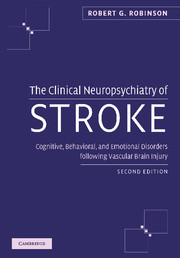 The Clinical Neuropsychiatry of Stroke
The Clinical Neuropsychiatry of Stroke Book contents
- Frontmatter
- Contents
- Preface
- Part I Introduction
- Part II Poststroke depression
- Part III Poststroke mania
- 24 Prevalence and clinical symptoms
- 25 Clinical and lesion correlates of poststroke mania
- 26 Bipolar disorder following stroke
- 27 Mechanism of mania following stroke
- 28 Treatment of mania following stroke
- Part IV Poststroke anxiety disorders
- Part V Other poststroke disorders
- Index
28 - Treatment of mania following stroke
from Part III - Poststroke mania
Published online by Cambridge University Press: 01 October 2009
- Frontmatter
- Contents
- Preface
- Part I Introduction
- Part II Poststroke depression
- Part III Poststroke mania
- 24 Prevalence and clinical symptoms
- 25 Clinical and lesion correlates of poststroke mania
- 26 Bipolar disorder following stroke
- 27 Mechanism of mania following stroke
- 28 Treatment of mania following stroke
- Part IV Poststroke anxiety disorders
- Part V Other poststroke disorders
- Index
Summary
A controlled double-blind treatment trial of secondary mania has not been conducted. Based on small series and anecdotal case reports, however, lithium has been the most commonly used treatment for secondary mania. There are reports, however, indicating that some cases have not responded to treatment with lithium. Some of these patients had a better response to carbamazepine or valproate and some did not respond to treatment. The treatment responses for the 19 patients in our study of bipolar disorder and mania only are shown in Fig. 28.1. Although there are clearly some patients who did not respond following treatment, most of the episodes of mania improved with treatment using lithium.
Of the total of 27 patients taken from all our studies of secondary mania, 10 of them clearly improved following treatment with lithium and only three clearly did not. In addition, three patients responded to a combination of carbamazepine and lithium, and two patients failed to respond to this treatment combination. The remaining patients were either not treated or treated with a tricyclic antidepressant which would not be expected to improve the manic symptoms.
In spite of the finding that most patients with secondary mania whom we studied responded to lithium treatment, there has been a general consensus in the anecdotal case literature that secondary mania tends to be more difficult to treat than primary mania (Shukla et al. 1987; Evans et al. 1995).
- Type
- Chapter
- Information
- The Clinical Neuropsychiatry of StrokeCognitive, Behavioral and Emotional Disorders following Vascular Brain Injury, pp. 314 - 316Publisher: Cambridge University PressPrint publication year: 2006


